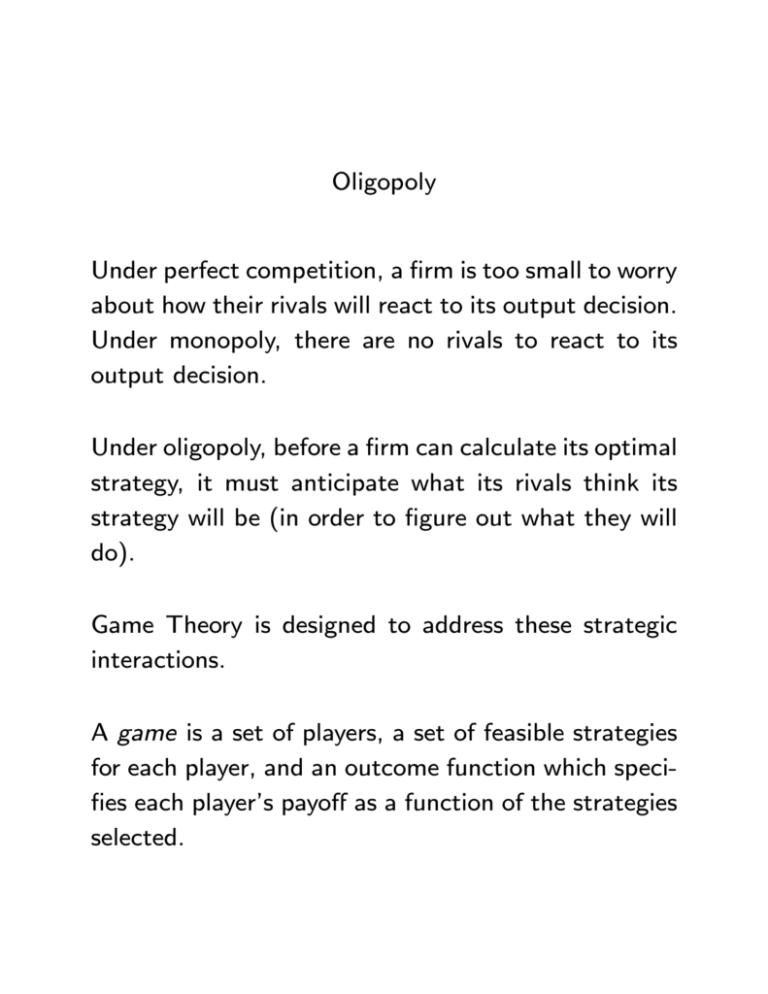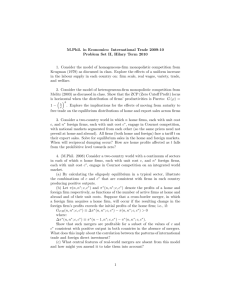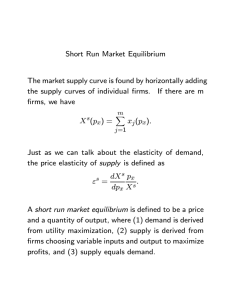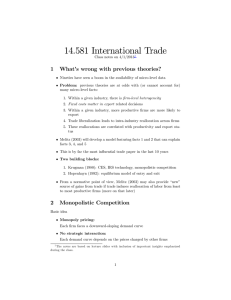Oligopoly Under perfect competition, a firm is too small to worry
advertisement

Oligopoly
Under perfect competition, a ¯rm is too small to worry
about how their rivals will react to its output decision.
Under monopoly, there are no rivals to react to its
output decision.
Under oligopoly, before a ¯rm can calculate its optimal
strategy, it must anticipate what its rivals think its
strategy will be (in order to ¯gure out what they will
do).
Game Theory is designed to address these strategic
interactions.
A game is a set of players, a set of feasible strategies
for each player, and an outcome function which speci¯es each player's payo® as a function of the strategies
selected.
A Nash equilibrium of a game is a choice of strategies,
one for each player, for which no player can receive a
higher payo® by deviating to another strategy, holding
the other players' strategies constant.
Example: Prisoner's Dilemma
Pepsi
high low
Coke high advertising 1,1
3,0
low advertising 0,3
2,2
Equilibrium is (high,high). No matter what the other
player does, you are better o® with high.
This is not purely confrontational. Both players could
bene¯t by signing a binding contract.
There should be a match between the environment
to be understood and the game you specify. The
following details can be important:
1. Whether the strategic choice is price, quantity, or
something in between (for example, if ¯rms set prices
but limit their quantity.
2. The timing of who moves ¯rst, or if moves are
simultaneous.
3. Whether ¯rms know their own costs or not; whether
¯rms know the costs of other ¯rms.
4. Whether consumers know the prices being charged
before they choose a ¯rm.
5. Do all ¯rms produce perfect substitutes, or is there
brand loyalty?
Quantity Competition vs. Price Competition
In the oil industry, competition is probably best described as choosing the quantity of oil to produce.
By the time the market opens, players have largely
committed to the quantity of oil they want to sell.
Firms bidding for contracts to supply the government
or \downstream" ¯rms are engaging in price competition.
The lowest bid is the price, and the ¯rm
placing the lowest bid supplies whatever quantity is
demanded.
Cournot (Quantity) Competition
For i = 1; 2, the strategic choice for ¯rm i is its output
quantity, xi. Given the outputs of the two duopolists,
the price is determined by the inverse demand curve,
px(x1 + x2).
Given how pro¯ts depend on x1 and x2, we can solve
for the Nash equilibrium, where each ¯rm's output is
a best response to the other ¯rm's output.
Example: Each ¯rm has the cost function, T C =
20xi, so average and marginal cost equals 20.
The market demand curve and inverse demand curves
are
x = 80 ¡ px
px = 80 ¡ x = 80 ¡ x1 ¡ x2:
Let us look at ¯rm 1's optimization problem. Pro¯ts
are
¼ 1 = (80 ¡ x1 ¡ x2)x1 ¡ 20x1:
(1)
Firm 1's best response to x2 (or what it believes will
be x2) is found by di®erentiating ¼ 1 with respect to
x1.
@¼ 1
= 0 = 80 ¡ 2x1 ¡ x2 ¡ 20:
@x1
Solving for x1, we have
60 ¡ x2
x1 =
:
2
(2)
Equation (2) is called ¯rm 1's reaction function, because it shows how ¯rm 1 optimally reacts to expectations of its rival's strategy.
Notice that if x2 = 0, ¯rm 1's best response is to
produce the monopoly quantity, 30.
The same procedure allows us to calculate the reaction
function for ¯rm 2:
60 ¡ x1
x2 =
:
(3)
2
The Nash equilibrium occurs when neither ¯rm has an
incentive to change its strategy, so we are on both reaction functions. Solving (2) and (3) simultaneously,
we have
x1 = 20;
x2 = 20; and therefore
px = 40; ¼ 1 = ¼ 2 = 400:
Notice that the price is between the monopoly price,
50, and the competitive price, 20.
Analysis of a Cartel
If the two ¯rms could conspire, they could increase
pro¯ts by reducing their output to 15 (half the monopoly
output). Then we would have px = 50; ¼ 1 = ¼ 2 =
450:
However, this is not a Nash equilibrium, and there is a
tendency to cheat. From (2), ¯rm 1's best response
to x2 = 15 is 22:5, which would yield ¼ 1 = 506:25.
This example illustrates why cartels are di±cult to
maintain. There is too much temptation to cheat,
especially if it takes time for rivals to see that you are
overproducing.
Repeated Quantity Competition
Oligopolies usually compete repeatedly over time, which
changes the game. A strategy now speci¯es your output, as a function of the observed history of outputs.
This opens the possibility of rewards and punishments.
Here is a strategy for ¯rm 1, where x1(t) is ¯rm 1's
output in round t:
x1(t) = 15
if
x2(1) = ¢ ¢ ¢ = x2(t ¡ 1) = 15
x1(t) = 20
otherwise.
In other words, ¯rm 1 produces the cartel output as
long as ¯rm 2 has never cheated, but reverts to the
one-shot Nash equilibrium if ¯rm 2 ever cheats.
If both ¯rms adopt the above \trigger" strategy, that
is a Nash equilibrium.
A ¯rm that deviates to an
output other than 15 at best receives pro¯ts of 506.25
during the round it cheats. However, its pro¯ts are
reduced from 450 to 400 every round afterwards.
Repeated play allows for tacit collusion, where there is
no conspiracy needed. The collusive cartel outcome
is self-enforcing. Thus, oligopolists can sometimes
achieve cartel pro¯ts legally.
Price Competition
Now ¯rm i's strategy is its choice of price, pix: Given
the prices, the ¯rm o®ering the lower price supplies
whatever is demanded at that price. If both ¯rms set
the same price, they split the market.
For our example, the solution is marginal cost pricing,
p1x = p2x = 20. Raising your price loses all customers,
and lowering your price yields negative pro¯ts. Fierce
competition to undercut your rival.
If the two ¯rms frequently bid against each other, tacit
collusion is again possible.
With quasi-¯xed costs, some degree of tacit collusion
might be the only way to avoid monopoly (since no
one wants to be the second ¯rm in)!
Miscellaneous
1. First mover advantage{installed capacity becomes
a ¯xed cost and can act as a threat.
Now your
marginal costs are lower than the long run marginal
cost of someone who has not yet entered.
2. Second mover advantage{observe the incumbent,
avoid R&D expenditures or better learn the nature of
demand.
3. Weakness can be strength{the incumbent will resist cannibalizing its current pro¯table product. Also,
a small ¯rm may not have to worry about attack (3
person duel).
4. Raise the cost of your rivals{encouraging costly
regulation could be to your advantage.











